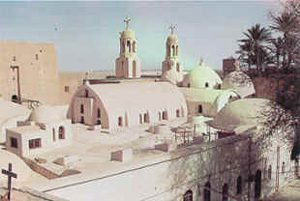
Dedicated to the Virgin of Baramus, Deir El-Baramus (also named the Monastery of the Romans) is probably the first monastery established in the Wadi El-Natron. The tradition of the place says that the monastery was built in the site where Saint Macarius lived. The name 'Baramus'– which means "That of the roman"– comes from a group of Romans who went to live in the monastery as early as St. Macarius himself, and on the place of their cells, after their death, a chapel was built. The monastery was identified also as the Monastery of Saint Moses the Black, who was an Ethiopian repented criminal, killed in the 5th century, during the attack of the nomads. Like the other buildings in the area, the monastery was damaged throughout the attacks of the desert nomads and was restored several times. In the 9th century, Patriarch Shenouda II built the walls around the monastery to protect it from the nomads' attacks. Covered by a thick layer of plaster, these wall (still survive) measure about 11 m high and 2 m thick. Above the walls, there is a walkway. The actual entrance is on the eastern side.
The Church of the Holy Virgin
Dating back to the 6th century, the basilica-styled Church of the Holy Virgin is the oldest church in Wadi El-Natron. The ceiling of the church is vaulted in the center and the aisles, with windows on both sides of the central nave. It comprises three sanctuaries, built in different eras since the 13th century. The sanctuary has domes built during the pontificate of Patriarch Gabriel III (1269-1271). There is a reliquary where the relics of many saints– such as Moses the Black, Isidore, Saints Maximus and Domitius– are preserved. The church's walls are decorated with paintings overlapped, from different historic periods. There are scenes of the Great Feast, Annunciation, the Visitation, the Nativity, the Baptism of Christ, the Wedding at Cana, the Entry into Jerusalem, the Feast of Pentecost, the Meeting of Ibrahim and Melchizedek Issaac, and a number of Coptic Saints. The Church has a baptistery and two chapels dedicated to Theodore Stratelates and Saint George.
